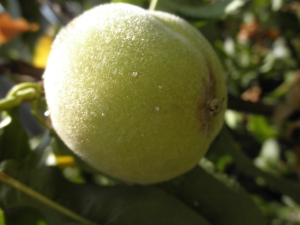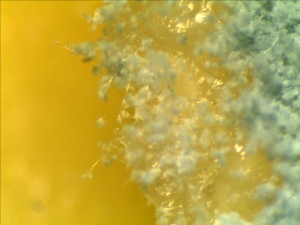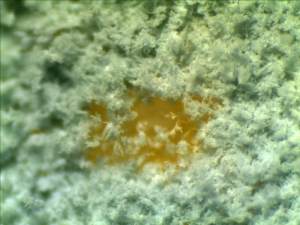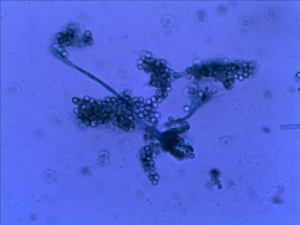Brown Rot is a serious disease for peach trees. This disease is caused by fungus, Monilinia fructicola. The M. fructicola can infect flowers, shoots, fruits and branches. Typical disease symptoms induced by M. fructicola include blossom and twig blight, cankers, and a fruit rot. Brown rot on the peach typically develops rapid brown necrosis. Under favored condition, the entire fruits can be rotten within 48 hours of infection.
M. fructicola over winters in dried infected fruit called peach mummies or in infected branch cankers. Mummies can either remain on tree or scatterd on ground. Both may produce spores which infect blossoms and young fruit in the spring. There are wo types of spore: ascospores and conidia. Ascospores are produced from apothecia, a mushroom-like structure that occurs only on mummies which have fallen to the ground and are partially covered with soil. Conidia are produced in abundance on mummies and infected twigs and may be spread by wind and rain.
Here at Georgia, nicknamed peach state, brown rot is the serious disease for commercial peach orchard. The peach tree in my backyard is not immuned from the disease. There are beautiful peach blossom during the spring but what follows is the ugly brown rot and fruit droppings all over the ground.

The symptoms on the fruits seems to start from a small insect bite where a small brown dot and clear gel like dischrage is clearly visible.

The brown rot was spread to half of the fruit. There are fruits droppings every where on the ground.

A completely rotten peach is hanging on the tree. It is also called peach mummy.

Another peach mummy
I collected some peach infected by brown rot and slice a thin layer of skin. Put it on my newly acquired Ample Scientific SM Plus stereo microscope with only the top light on.

Healthy Peach Skin at 20x.

The skin of brown rot infested peach. The skin turned brown even without clearly visible mycelium.

Peach pulp and skin

The pulp of a peach infected by brown rot. Half of the pulp has already turned brown.

The mycelium of Monilinia fructicola on a peach mummy.
A piece of peach mummy skin was sliced off and placed it in a vial with small amount of water. I gently scrap the surface with a dissecting tweezer, capped the vial and shacked for a few seconds. A simple wet mount and malachite green stain was applied to the specimen. The slide then observed at 400X with Nexcope CM701 compound microscope.

The pathogen that causes the peach brown rot. The picture is the conidia of Monilinia fructicola

two conidiospores formed on conidia (Monilinia fructicola)

Conidia of Monilinia fructicola
The specimens of conidia of Monilinia fructicola were stained with Malachite green. Photos were taken with Tucsen 3.0MP CMOS microscope camera using Zeiss AxioVision 4.8 LE image capture software. The eyepiece of the microscope was removed and replaced with Tucsen microscope camera adapter.
Couple days after I left the rotten peach in door. Rotten peach continued…
More web links about peach brown rot:
University of Georgia Peach Handbook – Brown Rot
Cornell University Tree Fruit and Berry Pathology
University of West Virginia KTFREC – Plant Disease Fact Sheet
Read Full Post »




















 Free Living FreshWater Protozoa by DJ Patterson
Free Living FreshWater Protozoa by DJ Patterson How to Know the Protozoa
How to Know the Protozoa Ecology and Classification of North American Freshwater Invertebrates by Thorp and Covich
Ecology and Classification of North American Freshwater Invertebrates by Thorp and Covich